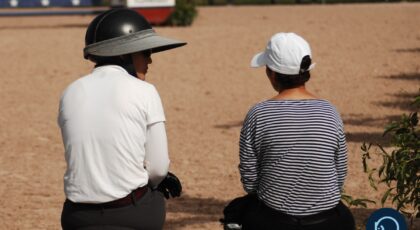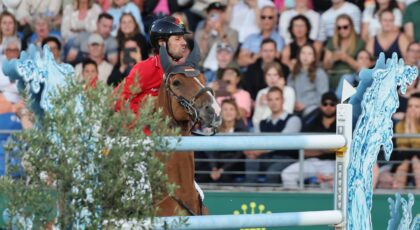Something interesting happened recently that served to drive home a central aspect of riding repeated time and time again by the classical masters; something I myself trying to teach my students as a matter of course.
I was giving an introduction lesson to a pair of prospective students. It is my standard practice in such situations to saddle up one of my own horses and give a short demonstration of my personal take on classical riding. Obviously, it is vital that I showcase the aspects of classical riding that most differ from what modern riders view as ‘correct’. To this end, I saddled up our Lipizzaner, Jupiter.

Jupiter
Watching these girls riding their ponies, I observed the standard riding style of many riders today. They kicked the horses to make them go, pulled back on the reins to stop, opening one rein to bend the horse in order to turn, etc..
So in an attempt to drive home how dramatically more subtle the aids can be combined to influence and guide the horse, I had chosen to ride Jupiter because he is currently the lighter and more responsive of our horses. I asked both girls to watch my ride and describe for me how I was maneuvering him precisely through and around obstacles, in balanced and collected gaits. I wanted to impress upon them the high level of connection Jupiter and I share, so I was consciously trying to conceal my aids by making them as light as possible.
Here is the epiphany: the more I focused on concealing my aids, the more responsive he became.
I have written in the past about the “nature of lightness” and how words like “light”, “gentle” and “firm” mean very different things to different people. For years I told my students to keep their aids light, but as time has passed my own understanding just how light light can be, keeps evolving. Still, I was amazed at how much more responsive Jupiter was to what seemed to be the slightest hint of an aid.

I came to realize the small issues I still have with him are based solely on the limits of my ability to keep the aids independent of his powerful movement. This is made even harder when I divide my attention between riding and focusing on competing. However, when I focused 100% on my riding with the goal of maintaining a flexible, consistent, outwardly imperceptible connection with him, he gave me back 100% willing acquiescence.
I know this sounds a lot like things most of us have heard before, but I encourage everyone to rethink this the next time they ride.
As a test I suggest you attempt to ride for a time as if you were trying to conceal your aids from an outside observer. Try to guide your horse through a collection of movements and gaits consciously doing as little as possible, seeking to connect with your horse to the point that while remaining totally relaxed, you are able to make him understand what you are thinking before telling him through stronger aids use.
Obviously the level of training a given horse has will determine just how connected the two of you can be, but riding like this will make every horse more responsive over time. Each ride, increase the aid to get the desired response and return to the lowest possible level the instant the horse indicates he understands.
The next time you ask, start by asking at this lower level and not at the level you had to rise to before. The more precisely you can apply your aids in concert with the correct movement of the horse, while remaining independent of that movement yourself, the lighter the aids can be applied effectively.
In time—if you are consistent in your work—I am sure you will come to a new understanding that light can be lighter than you ever thought possible, and with any luck, this process will continue for all of us throughout our riding careers.
Troy Griffith is a horse trainer and classical riding instructor based in Oregon. He is the owner and operator of Hands on Horse Training.

 June 3, 2016
June 3, 2016 

























